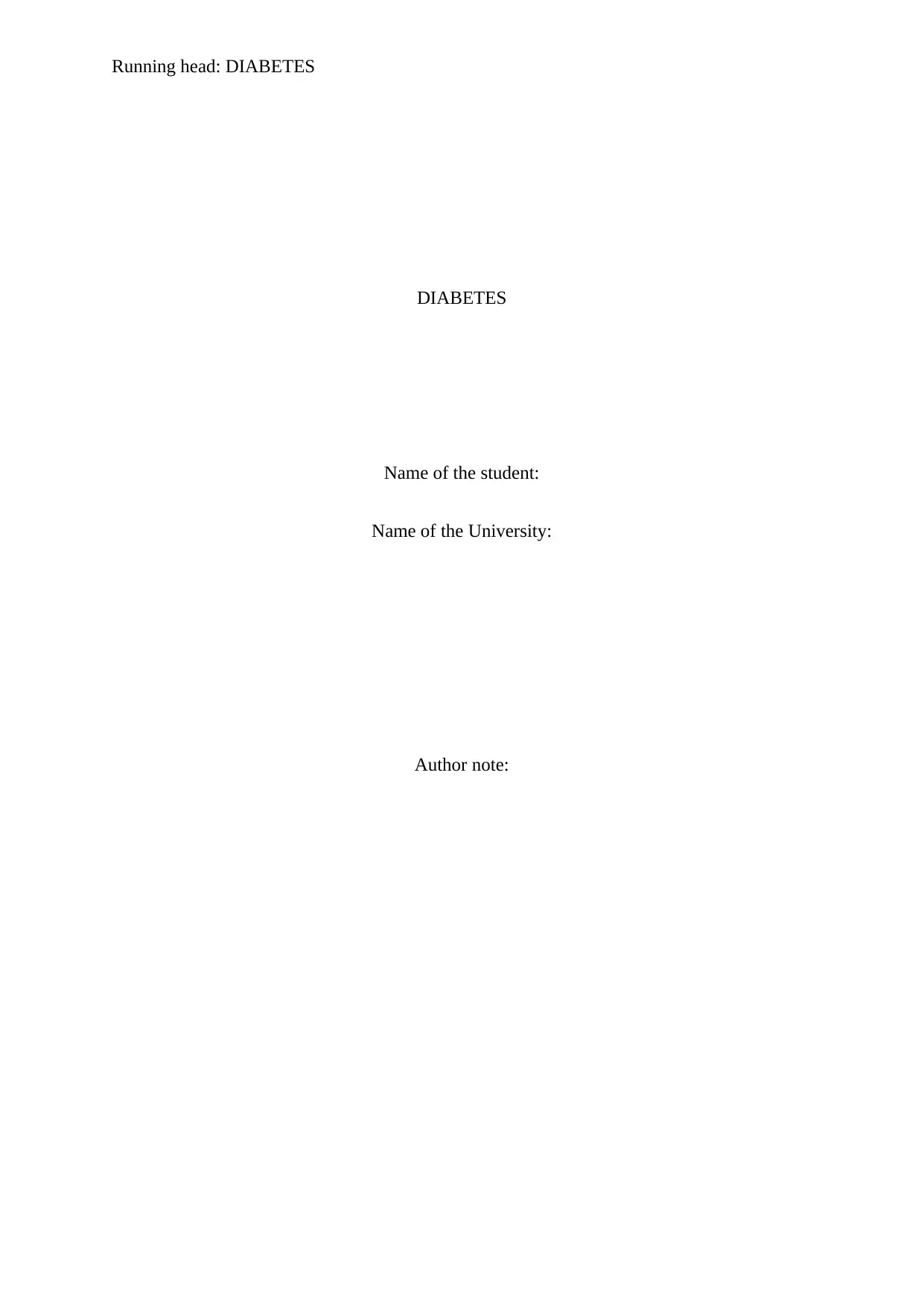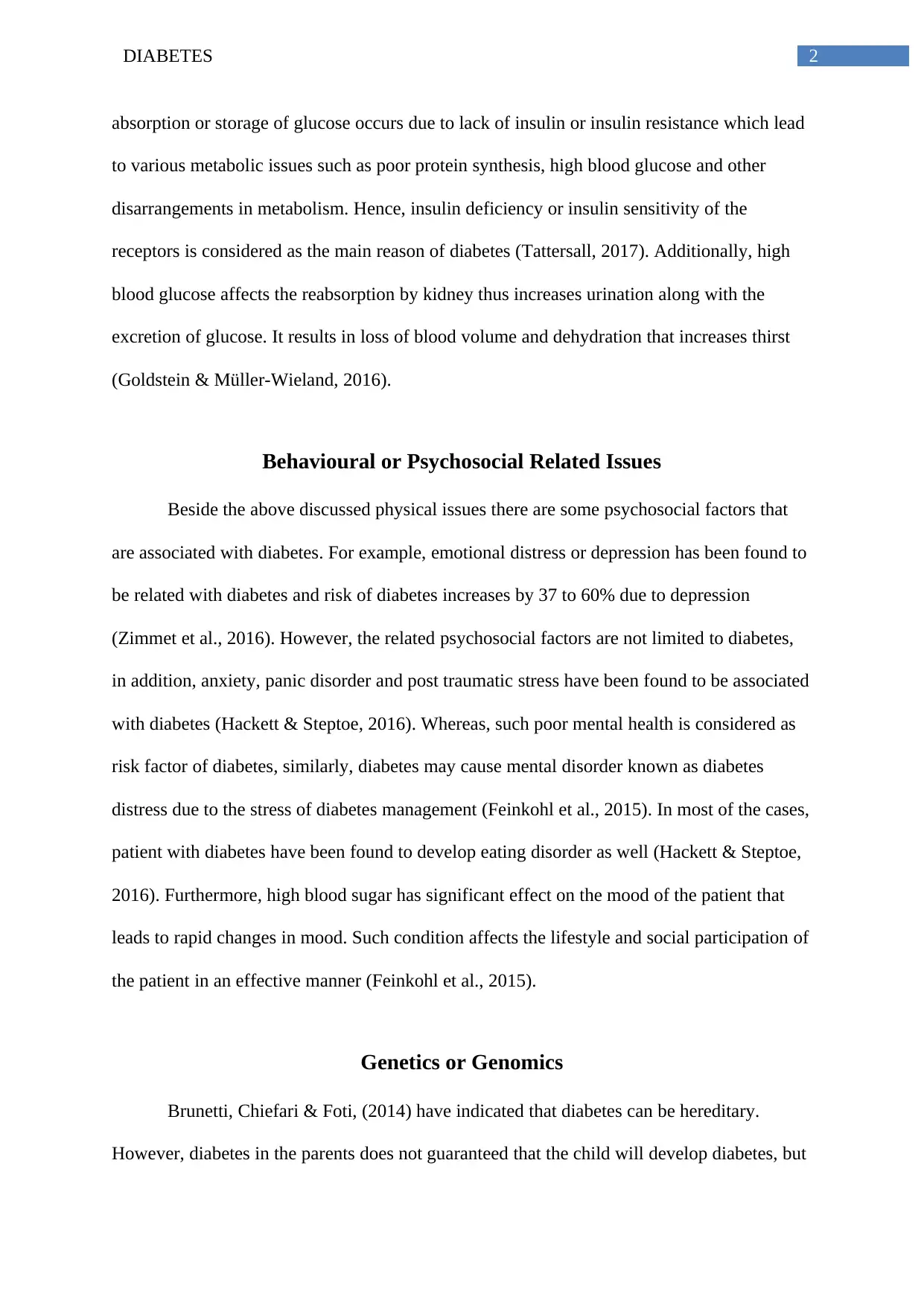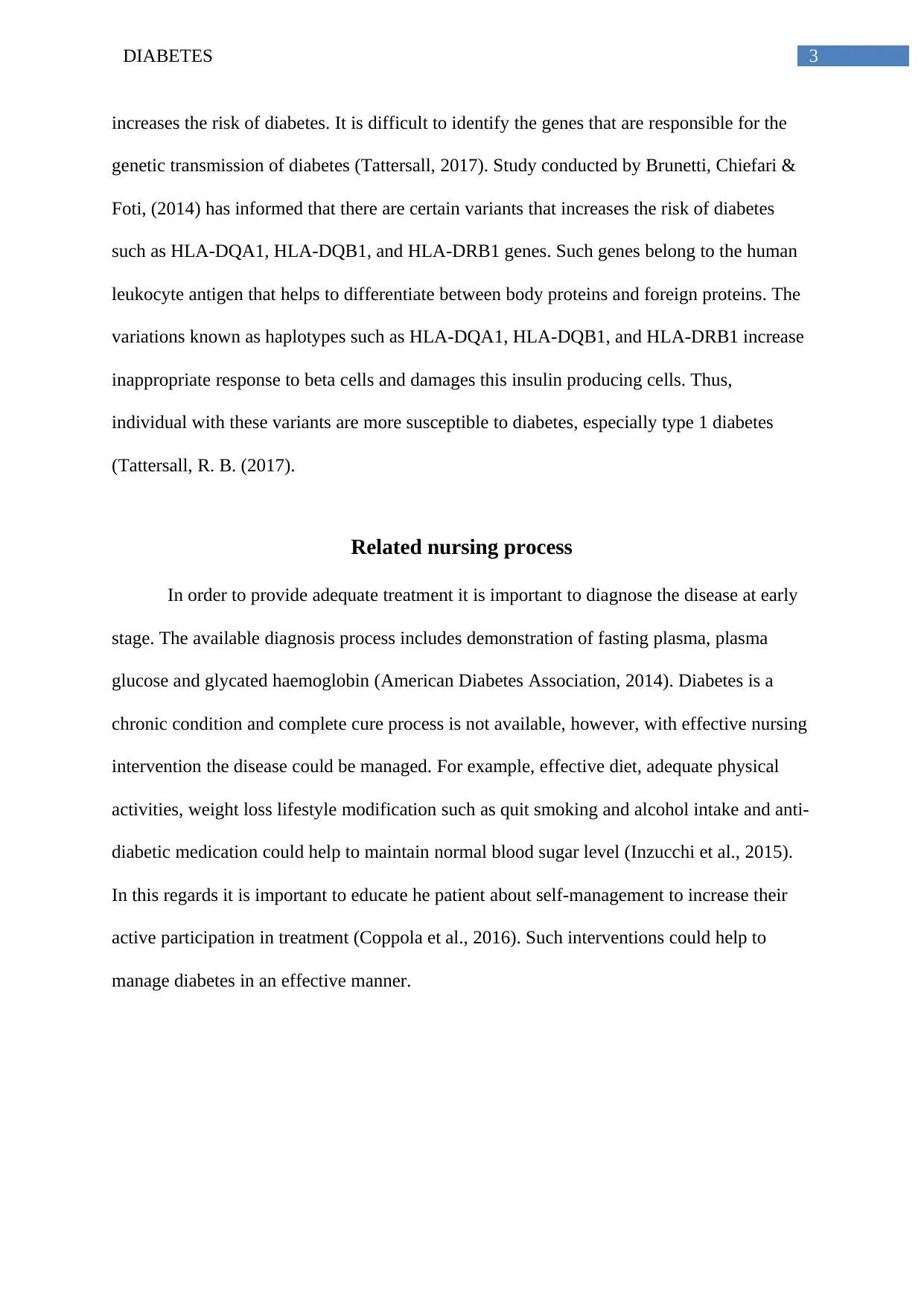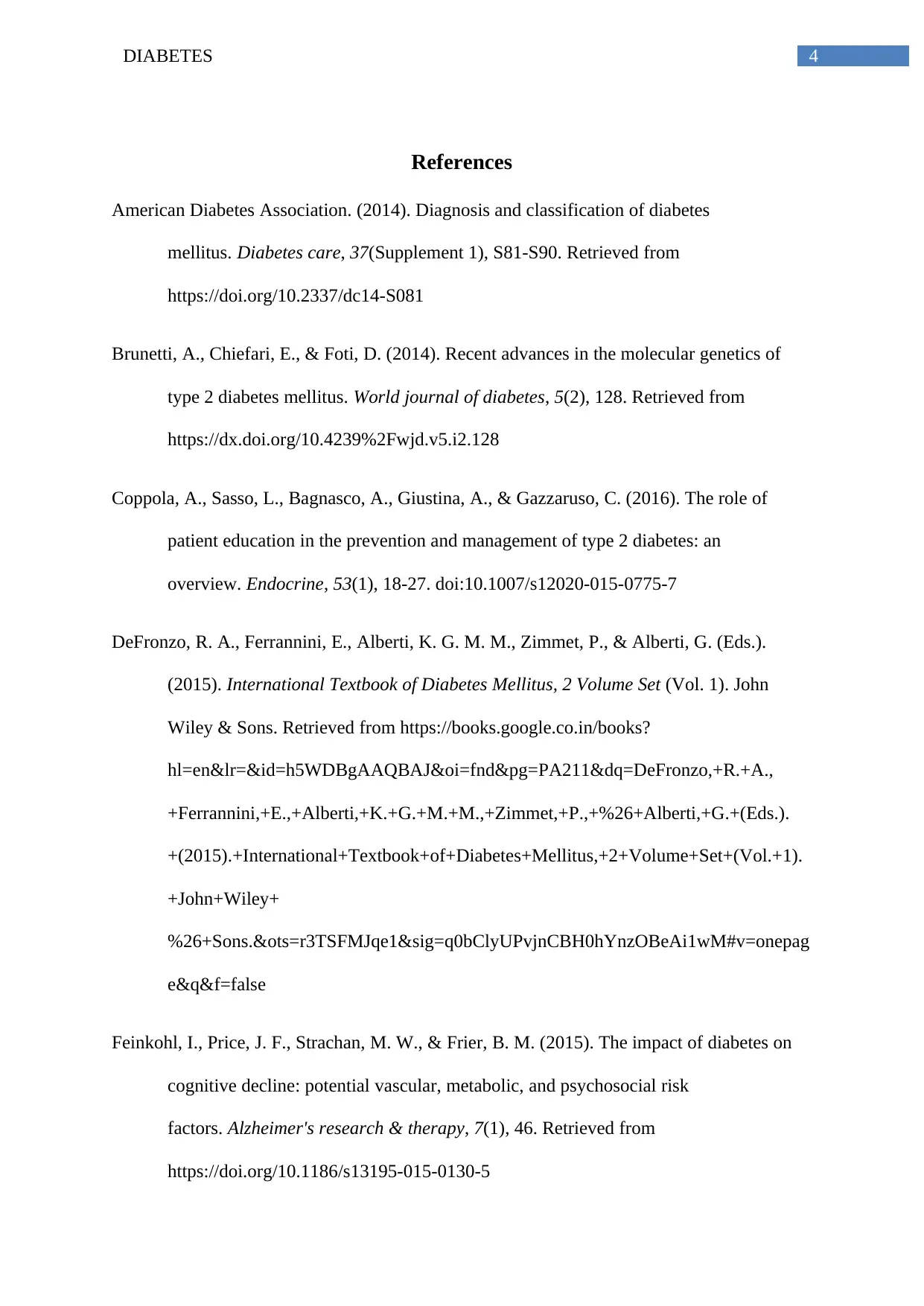Key Factors Associated with Diabetes: A Comprehensive Discussion
VerifiedAdded on 2023/06/04
|6
|1585
|287
AI Summary
This paper discusses the key factors associated with diabetes, including its pathophysiology, behavioural or psychosocial related issues, genetics or genomics, and related nursing process.
Contribute Materials
Your contribution can guide someone’s learning journey. Share your
documents today.

Running head: DIABETES
DIABETES
Name of the student:
Name of the University:
Author note:
DIABETES
Name of the student:
Name of the University:
Author note:
Secure Best Marks with AI Grader
Need help grading? Try our AI Grader for instant feedback on your assignments.

1DIABETES
Disease or disorder
This paper aims to discuss the key factors associated with diabetes. According to the
doctors diabetes is mainly referred to the consequence of diabetes mellitus (DeFronzo et al.,
2015). The condition is described as the combination of various metabolic diseases that lead
to high blood sugar (glucose). The consequences of diabetes may occur due to inadequate
production of insulin or due to the poor response of cells to insulin, or in some cases both.
Common sufferings such as frequent urination, increasing hunger and thirst are associated
with diabetes (Tattersall, 2017). The disease can be classified into three major types such as
type 1 diabetes, type 2 diabetes and gestational diabetes (American Diabetes Association,
2014). Type 1 diabetes mainly occurs when the pancreas fails to produce adequate amount of
insulin and the prevalence has been found to be 10% (Zimmet et al., 2016). 90% of diabetes
cases are associated with type 2 diabetes which causes due to the inability of cells to response
to the insulin or insulin resistance and gestational diabetes affects the women during the
period of pregnancy (Goldstein & Müller-Wieland, 2016). Further the disease has become
global concern as it may lead to severe cardiovascular risk (Tattersall, 2017).
Detailed Pathophysiology
The main consequence of diabetes is the high blood sugar or glucose. Glucose is
mainly obtained by the absorption of food, glycogen breakdown and storage in liver and
glucose production through non-carbohydrate elements by gluconeogenesis. In this regards
insulin play an important role in order to maintain the glucose balance in the body. It could
inhibit the gluconeogenesis or glycogen breakdown and stimulate glucose transport and its
storage as glycogen (DeFronzo et al., 2015). Insulin plays the instrumental role in the glucose
uptake by muscle, adipose tissue and liver from blood in order to produce energy. Thus, poor
Disease or disorder
This paper aims to discuss the key factors associated with diabetes. According to the
doctors diabetes is mainly referred to the consequence of diabetes mellitus (DeFronzo et al.,
2015). The condition is described as the combination of various metabolic diseases that lead
to high blood sugar (glucose). The consequences of diabetes may occur due to inadequate
production of insulin or due to the poor response of cells to insulin, or in some cases both.
Common sufferings such as frequent urination, increasing hunger and thirst are associated
with diabetes (Tattersall, 2017). The disease can be classified into three major types such as
type 1 diabetes, type 2 diabetes and gestational diabetes (American Diabetes Association,
2014). Type 1 diabetes mainly occurs when the pancreas fails to produce adequate amount of
insulin and the prevalence has been found to be 10% (Zimmet et al., 2016). 90% of diabetes
cases are associated with type 2 diabetes which causes due to the inability of cells to response
to the insulin or insulin resistance and gestational diabetes affects the women during the
period of pregnancy (Goldstein & Müller-Wieland, 2016). Further the disease has become
global concern as it may lead to severe cardiovascular risk (Tattersall, 2017).
Detailed Pathophysiology
The main consequence of diabetes is the high blood sugar or glucose. Glucose is
mainly obtained by the absorption of food, glycogen breakdown and storage in liver and
glucose production through non-carbohydrate elements by gluconeogenesis. In this regards
insulin play an important role in order to maintain the glucose balance in the body. It could
inhibit the gluconeogenesis or glycogen breakdown and stimulate glucose transport and its
storage as glycogen (DeFronzo et al., 2015). Insulin plays the instrumental role in the glucose
uptake by muscle, adipose tissue and liver from blood in order to produce energy. Thus, poor

2DIABETES
absorption or storage of glucose occurs due to lack of insulin or insulin resistance which lead
to various metabolic issues such as poor protein synthesis, high blood glucose and other
disarrangements in metabolism. Hence, insulin deficiency or insulin sensitivity of the
receptors is considered as the main reason of diabetes (Tattersall, 2017). Additionally, high
blood glucose affects the reabsorption by kidney thus increases urination along with the
excretion of glucose. It results in loss of blood volume and dehydration that increases thirst
(Goldstein & Müller-Wieland, 2016).
Behavioural or Psychosocial Related Issues
Beside the above discussed physical issues there are some psychosocial factors that
are associated with diabetes. For example, emotional distress or depression has been found to
be related with diabetes and risk of diabetes increases by 37 to 60% due to depression
(Zimmet et al., 2016). However, the related psychosocial factors are not limited to diabetes,
in addition, anxiety, panic disorder and post traumatic stress have been found to be associated
with diabetes (Hackett & Steptoe, 2016). Whereas, such poor mental health is considered as
risk factor of diabetes, similarly, diabetes may cause mental disorder known as diabetes
distress due to the stress of diabetes management (Feinkohl et al., 2015). In most of the cases,
patient with diabetes have been found to develop eating disorder as well (Hackett & Steptoe,
2016). Furthermore, high blood sugar has significant effect on the mood of the patient that
leads to rapid changes in mood. Such condition affects the lifestyle and social participation of
the patient in an effective manner (Feinkohl et al., 2015).
Genetics or Genomics
Brunetti, Chiefari & Foti, (2014) have indicated that diabetes can be hereditary.
However, diabetes in the parents does not guaranteed that the child will develop diabetes, but
absorption or storage of glucose occurs due to lack of insulin or insulin resistance which lead
to various metabolic issues such as poor protein synthesis, high blood glucose and other
disarrangements in metabolism. Hence, insulin deficiency or insulin sensitivity of the
receptors is considered as the main reason of diabetes (Tattersall, 2017). Additionally, high
blood glucose affects the reabsorption by kidney thus increases urination along with the
excretion of glucose. It results in loss of blood volume and dehydration that increases thirst
(Goldstein & Müller-Wieland, 2016).
Behavioural or Psychosocial Related Issues
Beside the above discussed physical issues there are some psychosocial factors that
are associated with diabetes. For example, emotional distress or depression has been found to
be related with diabetes and risk of diabetes increases by 37 to 60% due to depression
(Zimmet et al., 2016). However, the related psychosocial factors are not limited to diabetes,
in addition, anxiety, panic disorder and post traumatic stress have been found to be associated
with diabetes (Hackett & Steptoe, 2016). Whereas, such poor mental health is considered as
risk factor of diabetes, similarly, diabetes may cause mental disorder known as diabetes
distress due to the stress of diabetes management (Feinkohl et al., 2015). In most of the cases,
patient with diabetes have been found to develop eating disorder as well (Hackett & Steptoe,
2016). Furthermore, high blood sugar has significant effect on the mood of the patient that
leads to rapid changes in mood. Such condition affects the lifestyle and social participation of
the patient in an effective manner (Feinkohl et al., 2015).
Genetics or Genomics
Brunetti, Chiefari & Foti, (2014) have indicated that diabetes can be hereditary.
However, diabetes in the parents does not guaranteed that the child will develop diabetes, but

3DIABETES
increases the risk of diabetes. It is difficult to identify the genes that are responsible for the
genetic transmission of diabetes (Tattersall, 2017). Study conducted by Brunetti, Chiefari &
Foti, (2014) has informed that there are certain variants that increases the risk of diabetes
such as HLA-DQA1, HLA-DQB1, and HLA-DRB1 genes. Such genes belong to the human
leukocyte antigen that helps to differentiate between body proteins and foreign proteins. The
variations known as haplotypes such as HLA-DQA1, HLA-DQB1, and HLA-DRB1 increase
inappropriate response to beta cells and damages this insulin producing cells. Thus,
individual with these variants are more susceptible to diabetes, especially type 1 diabetes
(Tattersall, R. B. (2017).
Related nursing process
In order to provide adequate treatment it is important to diagnose the disease at early
stage. The available diagnosis process includes demonstration of fasting plasma, plasma
glucose and glycated haemoglobin (American Diabetes Association, 2014). Diabetes is a
chronic condition and complete cure process is not available, however, with effective nursing
intervention the disease could be managed. For example, effective diet, adequate physical
activities, weight loss lifestyle modification such as quit smoking and alcohol intake and anti-
diabetic medication could help to maintain normal blood sugar level (Inzucchi et al., 2015).
In this regards it is important to educate he patient about self-management to increase their
active participation in treatment (Coppola et al., 2016). Such interventions could help to
manage diabetes in an effective manner.
increases the risk of diabetes. It is difficult to identify the genes that are responsible for the
genetic transmission of diabetes (Tattersall, 2017). Study conducted by Brunetti, Chiefari &
Foti, (2014) has informed that there are certain variants that increases the risk of diabetes
such as HLA-DQA1, HLA-DQB1, and HLA-DRB1 genes. Such genes belong to the human
leukocyte antigen that helps to differentiate between body proteins and foreign proteins. The
variations known as haplotypes such as HLA-DQA1, HLA-DQB1, and HLA-DRB1 increase
inappropriate response to beta cells and damages this insulin producing cells. Thus,
individual with these variants are more susceptible to diabetes, especially type 1 diabetes
(Tattersall, R. B. (2017).
Related nursing process
In order to provide adequate treatment it is important to diagnose the disease at early
stage. The available diagnosis process includes demonstration of fasting plasma, plasma
glucose and glycated haemoglobin (American Diabetes Association, 2014). Diabetes is a
chronic condition and complete cure process is not available, however, with effective nursing
intervention the disease could be managed. For example, effective diet, adequate physical
activities, weight loss lifestyle modification such as quit smoking and alcohol intake and anti-
diabetic medication could help to maintain normal blood sugar level (Inzucchi et al., 2015).
In this regards it is important to educate he patient about self-management to increase their
active participation in treatment (Coppola et al., 2016). Such interventions could help to
manage diabetes in an effective manner.
Secure Best Marks with AI Grader
Need help grading? Try our AI Grader for instant feedback on your assignments.

4DIABETES
References
American Diabetes Association. (2014). Diagnosis and classification of diabetes
mellitus. Diabetes care, 37(Supplement 1), S81-S90. Retrieved from
https://doi.org/10.2337/dc14-S081
Brunetti, A., Chiefari, E., & Foti, D. (2014). Recent advances in the molecular genetics of
type 2 diabetes mellitus. World journal of diabetes, 5(2), 128. Retrieved from
https://dx.doi.org/10.4239%2Fwjd.v5.i2.128
Coppola, A., Sasso, L., Bagnasco, A., Giustina, A., & Gazzaruso, C. (2016). The role of
patient education in the prevention and management of type 2 diabetes: an
overview. Endocrine, 53(1), 18-27. doi:10.1007/s12020-015-0775-7
DeFronzo, R. A., Ferrannini, E., Alberti, K. G. M. M., Zimmet, P., & Alberti, G. (Eds.).
(2015). International Textbook of Diabetes Mellitus, 2 Volume Set (Vol. 1). John
Wiley & Sons. Retrieved from https://books.google.co.in/books?
hl=en&lr=&id=h5WDBgAAQBAJ&oi=fnd&pg=PA211&dq=DeFronzo,+R.+A.,
+Ferrannini,+E.,+Alberti,+K.+G.+M.+M.,+Zimmet,+P.,+%26+Alberti,+G.+(Eds.).
+(2015).+International+Textbook+of+Diabetes+Mellitus,+2+Volume+Set+(Vol.+1).
+John+Wiley+
%26+Sons.&ots=r3TSFMJqe1&sig=q0bClyUPvjnCBH0hYnzOBeAi1wM#v=onepag
e&q&f=false
Feinkohl, I., Price, J. F., Strachan, M. W., & Frier, B. M. (2015). The impact of diabetes on
cognitive decline: potential vascular, metabolic, and psychosocial risk
factors. Alzheimer's research & therapy, 7(1), 46. Retrieved from
https://doi.org/10.1186/s13195-015-0130-5
References
American Diabetes Association. (2014). Diagnosis and classification of diabetes
mellitus. Diabetes care, 37(Supplement 1), S81-S90. Retrieved from
https://doi.org/10.2337/dc14-S081
Brunetti, A., Chiefari, E., & Foti, D. (2014). Recent advances in the molecular genetics of
type 2 diabetes mellitus. World journal of diabetes, 5(2), 128. Retrieved from
https://dx.doi.org/10.4239%2Fwjd.v5.i2.128
Coppola, A., Sasso, L., Bagnasco, A., Giustina, A., & Gazzaruso, C. (2016). The role of
patient education in the prevention and management of type 2 diabetes: an
overview. Endocrine, 53(1), 18-27. doi:10.1007/s12020-015-0775-7
DeFronzo, R. A., Ferrannini, E., Alberti, K. G. M. M., Zimmet, P., & Alberti, G. (Eds.).
(2015). International Textbook of Diabetes Mellitus, 2 Volume Set (Vol. 1). John
Wiley & Sons. Retrieved from https://books.google.co.in/books?
hl=en&lr=&id=h5WDBgAAQBAJ&oi=fnd&pg=PA211&dq=DeFronzo,+R.+A.,
+Ferrannini,+E.,+Alberti,+K.+G.+M.+M.,+Zimmet,+P.,+%26+Alberti,+G.+(Eds.).
+(2015).+International+Textbook+of+Diabetes+Mellitus,+2+Volume+Set+(Vol.+1).
+John+Wiley+
%26+Sons.&ots=r3TSFMJqe1&sig=q0bClyUPvjnCBH0hYnzOBeAi1wM#v=onepag
e&q&f=false
Feinkohl, I., Price, J. F., Strachan, M. W., & Frier, B. M. (2015). The impact of diabetes on
cognitive decline: potential vascular, metabolic, and psychosocial risk
factors. Alzheimer's research & therapy, 7(1), 46. Retrieved from
https://doi.org/10.1186/s13195-015-0130-5

5DIABETES
Goldstein, B. J., & Müller-Wieland, D. (Eds.). (2016). Type 2 diabetes: principles and
practice. CRC Press. 2nd edition. 13-452. Retrieved from
https://books.google.co.in/books?
hl=en&lr=&id=dMKc6OTvX3EC&oi=fnd&pg=PP1&dq=+Type+2+diabetes:
+principles+and+practice.
+&ots=Bur_JZShoW&sig=wFDo8gCEHmur2fmcPJJZZ9RD-
QE#v=onepage&q=Type%202%20diabetes%3A%20principles%20and
%20practice.&f=false
Hackett, R. A., & Steptoe, A. (2016). Psychosocial factors in diabetes and cardiovascular
risk. Current cardiology reports, 18(10), 95. doi: 10.1007/s11886-016-0771-4
Inzucchi, S. E., Bergenstal, R. M., Buse, J. B., Diamant, M., Ferrannini, E., Nauck, M., ... &
Matthews, D. R. (2015). Management of hyperglycemia in type 2 diabetes, 2015: a
patient-centered approach: update to a position statement of the American Diabetes
Association and the European Association for the Study of Diabetes. Diabetes
care, 38(1), 140-149. Retrieved from https://doi.org/10.2337/dc14-2441
Tattersall, R. B. (2017). The history of diabetes mellitus. Textbook of diabetes, 1-22.
Retrieved from https://doi.org/10.1002/9781118924853.ch1
Zimmet, P., Alberti, K. G., Magliano, D. J., & Bennett, P. H. (2016). Diabetes mellitus
statistics on prevalence and mortality: facts and fallacies. Nature Reviews
Endocrinology, 12(10), 616. Retrieved from
https://www.nature.com/articles/nrendo.2016.105
Goldstein, B. J., & Müller-Wieland, D. (Eds.). (2016). Type 2 diabetes: principles and
practice. CRC Press. 2nd edition. 13-452. Retrieved from
https://books.google.co.in/books?
hl=en&lr=&id=dMKc6OTvX3EC&oi=fnd&pg=PP1&dq=+Type+2+diabetes:
+principles+and+practice.
+&ots=Bur_JZShoW&sig=wFDo8gCEHmur2fmcPJJZZ9RD-
QE#v=onepage&q=Type%202%20diabetes%3A%20principles%20and
%20practice.&f=false
Hackett, R. A., & Steptoe, A. (2016). Psychosocial factors in diabetes and cardiovascular
risk. Current cardiology reports, 18(10), 95. doi: 10.1007/s11886-016-0771-4
Inzucchi, S. E., Bergenstal, R. M., Buse, J. B., Diamant, M., Ferrannini, E., Nauck, M., ... &
Matthews, D. R. (2015). Management of hyperglycemia in type 2 diabetes, 2015: a
patient-centered approach: update to a position statement of the American Diabetes
Association and the European Association for the Study of Diabetes. Diabetes
care, 38(1), 140-149. Retrieved from https://doi.org/10.2337/dc14-2441
Tattersall, R. B. (2017). The history of diabetes mellitus. Textbook of diabetes, 1-22.
Retrieved from https://doi.org/10.1002/9781118924853.ch1
Zimmet, P., Alberti, K. G., Magliano, D. J., & Bennett, P. H. (2016). Diabetes mellitus
statistics on prevalence and mortality: facts and fallacies. Nature Reviews
Endocrinology, 12(10), 616. Retrieved from
https://www.nature.com/articles/nrendo.2016.105
1 out of 6
Related Documents
Your All-in-One AI-Powered Toolkit for Academic Success.
+13062052269
info@desklib.com
Available 24*7 on WhatsApp / Email
![[object Object]](/_next/static/media/star-bottom.7253800d.svg)
Unlock your academic potential
© 2024 | Zucol Services PVT LTD | All rights reserved.





